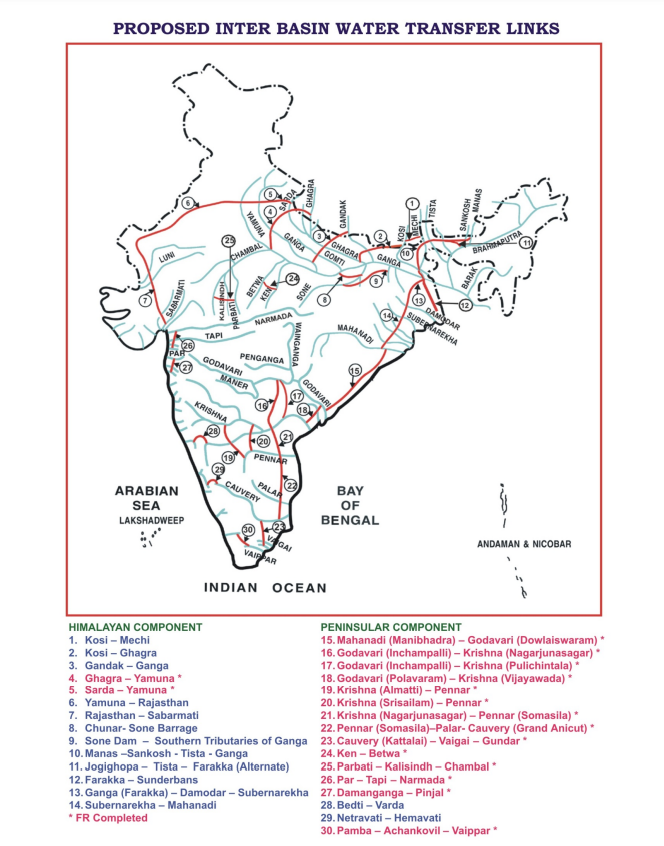-
26 Jul 2022
GS Paper 3
Bio-diversity & Environment
Day 16: Discuss the negative impacts of the River Interlinking Projects with suitable examples. (150 Words)
- Introduce River Interlinking projects (RIP) and its significance.
- Discuss the negative impacts of the RIP with example.
- Conclude suitably with a way forward approach.
Answer
River Interlinking projects (RIP) is to ensure greater equity in the distribution of water by enhancing the availability of water in drought prone and rain-fed areas. It is also known as the National Perspective Plan (NPP).
The National Perspective Plan (NPP) was prepared by the Ministry of Irrigation (now Ministry of Jal Shakti) in 1980. Under NPP, 30 links have been identified covering 14 links under Himalayan Rivers Component and 16 links under Peninsular Rivers Component for inter basin transfer of water based on field surveys and investigation and detailed studies.
An interlinking project would reach the implementation stage once agreement amongst party states (consensus) is reached on water sharing.
Some examples of the interlinking of rivers:
- Ken-Betwa link: The project envisages transferring water from the Ken River to the Betwa river, both tributaries of the Yamuna. It is the first project under the National Perspective Plan for interlinking rivers.
- Mahanadi (Manibhadra) – Godavari (Dowlaiswaram) link
- Godavari (Inchampalli) – Krishna (Nagarjunasagar) link
- Krishna (Almatti) – Pennar link
- Pennar (Somasila) – Cauvery (Grand Anicut) link
- Par-Tapi – Narmada link
- Damanganga – Pinjal link
Significance of the River Interlinking Projects
- Reducing Regional Imbalance: India depends on monsoon rains that are erratic as well as regionally imbalanced. The interlinking of rivers will reduce the amount of surplus rain and river water which flows into the sea.
- Irrigation for Agriculture: Interlinking can provide a solution to the rain-fed irrigation problems of Indian agriculture through the transfer of surplus water to deficit regions.
- Reducing Water Distress: This can help in mitigating the effect of drought and floods to a certain extent.
- Other Benefits: Hydropower generation, Round the year navigation, Employment generation, Ecological benefits as dried up forests and lands will be replenished.
Negative impacts of the River Interlinking Projects
Ecological and environmental issues:
- There are knowledge gaps between the claimed benefits and potential threats from environment and ecological impact.
- Feasibility of flood control and drought protection is under question because almost all rivers own very less water than required in lean season and lean season of almost all rivers is similar due to monsoon nature of India.
- There is uncertainty about how much water will be shifted and when, whether this may cause water logging, salinity/alkalinity and the resulting desertification in the command areas of these projects.
- Rivers may change their courses every (approximately) 100 years, so the interlinking may not be useful after 100 years.
- Interlinking may also lead to deforestation and cause ecological imbalances (e.g., Submergence of Panna Biosphere Reserve).
- Shifting water from the river may cause diversity loss in the parent river due to less water and in the receiving river due to accelerated erosion.
Socio-Economic Issues:
- The need of massive storage capacities will cause displacement of vulnerable (Tribals, villagers, etc.), poor river and ground water quality and fertile land and forest submergence.
- India has yet to rehabilitate approx. 50% of people displaced due to previous water storage facilities.
- It will force million people in poverty due to displacement and this will increase the fiscal burden of government for pro-poor scheme.
International Issues:
- A good no. of large rivers of India are trans-national. Cooperation of neighboring countries is a prerequisite for better relations and already India is facing no. of water sharing challenges e.g., India-Bangladesh on Farakka barrage, India-China on Brahmaputra and India-Pak on the Indus system.
- Massive water storing facilities in India on downstream rivers, of trans-national nature, may be used against interest of India in the situation of war and hostilities. E.g., China and water bomb theory.
Technological Developments:
- Cost of power generation by solar power projects would be below Rs. 1.0 per Kwh in a few years.
- Availability of cheaper, clean and perennial/renewable power would favour more water lifting/pumping and tunnels in the river link projects rather than purely gravity links to economies on cost, reduce construction time and reduce land submergence by optimum use of existing reservoirs/less storage, etc.
- India has yet to manage its water leakage problem in cities and rural areas, the leakage situation in river and canal linking via tunnel and pipe will make the situation worse.
Political Views:
- Conflicting views by interstate governments and parties at central govt will make it difficult to reach consensus, which is prerequisite for any river interlinking project.
To mitigate the increasing demand of water and minimise the effects of flood and drought we have to focus on the small-small decentralised water conservation program to fulfil local needs instead of mega projects.






